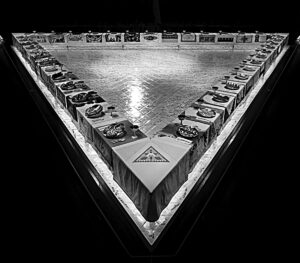The 2023 Midwest Women Artists Symposium held from Oct. 19-21 at Bradley University was the first hybrid symposium conducted by the Illinois Women Artists Project. This event was created in 2011 by the Bradley Department of Art alongside IWAP. These symposiums are free public events that help bring attention to various women artists working in the Midwest while also working to present new information and prompt conversation among the local community.
The first day at BU’s Caterpillar Communications Center featured speaker Catherine J. Morris, curator of the Elizabeth A. Sackler Center for Feminist Art at Brooklyn Museum. Morris has spent her curatorial career focusing on the ways in which feminism works to shape the way we view, receive, and create art. Morris has worked diligently to curate exhibitions that lend agency to voices less commonly referred to in the canon of art history.

The 1970s iconic creation ‘Dinner Party’ by Judy Chicago was made with ceramic, porcelain and textile.
New rules
One of the most notable pieces is Judy Chicago’s “The Dinner Party.” Her goal with this work was inspired by the 1970s feminist movement and aimed to rewrite the history of what she had been previously taught. This exhibition helped to revise previously told narratives about art history that were commonly dominated by white male figures, and instead redistributed power to previously excluded voices. Morris stresses that “feminism as it exists into the future needs to adapt to the times in which it exists.”
Morris’ presentation at the 2023 Midwest Women Artists Symposium discussed the work and life of African-American sculptor and graphic artist Elizabeth Catlett through a feminist lens. A notable amount of Catlett’s work addresses not only the female experience but also the complicity of society’s injustice against black women. Her work confronts the intersectionality of what it meant to be both Black and a woman living through the Civil Rights Movement.
In addition to Morris, there were six other presentations and a performance as well. Marcella Hackbardt, curator and professor of art at Kenyon College, gave a presentation highlighting the way in which contemporary women artists have used art as a tool to create new narratives. This revision of previous narratives encourages the viewer to rethink their perception of power dynamics, politics, and the societal norms that they often find themselves complacent participating in. The following presentation by Natalie Phillips, professor at Ball State University, reviewed the work of three Midwestern women artists utilizing playful and curious attitudes as they work to create art depicting their personal feelings of displacement. The discussed artists — Patty Carroll (Chicago), Jacinda Russell (Indiana), and Nirmal Raja (Milwaukee) — all use their art to express their search for a sense of belonging as women artists working in the Midwest.
Multi media
Cherrie Sampson performed a work in progress that remarks on the universal qualities of feminine human existences. These qualities include concepts of acceptance, survival, illness, and human reality. Sampson’s project combines an audio montage taken from the 72 hours following a diagnosis of hereditary breast cancer with various video clips that work to instill the viewer with a sense of uncertainty. The audio was taken from numerous sources including phone calls with family members as well as discussion with doctors and workers to represent the overwhelming sense of confusion while navigating a life-altering diagnosis.
Fern Shaffer, a self-proclaimed feminist artist currently working in the city of Chicago, visited to give an in-person presentation discussing the spirituality and connection of existence. Shaffer’s work focuses on the notion that all life is interconnected; furthermore, it discusses how beginning to accept the alignments of plants and ecology allows us to recognize patterns of collective experience that shape human existence. Shaffer says she is currently working on creating an installation piece consisting of 1,200 individually painted moons which will be shown together in order to create an immersive viewing experience.
From Shaffer’s talk of spirituality and connection we moved into a presentation by multidisciplinary art from Judy Chicago, then to Ginny Sykes commenting on love and the place it plays in the collaborative work of women artists.
Deeply influenced by Carl Jung, Sykes works to explore the intermingling of love and artistic practice. Through her review of various collaborative works she provides evidence that love not only affects the creative process but also manifests within the piece of work itself.
Virtual program
The two final presentations of the Midwest Women Artists Symposium were available virtually. Angela Shaffer, a working artist currently living in Columbia, Mo., discussed her photography work from her MFA thesis “for dear life: Using Photography to Bring Visibility to Emotional and Psychological Labor of motherhood.” She discusses the work of five artists, including herself, to explore the various forms of labor associated with motherhood as it pertains to the context of matricentric feminism.
The last presenter, Gina Yang, is an independent scholar in Massachusetts working to bring more attention to Deaf View/Image Art (De’VIA). Deaf View/Image Art works to examine the Deaf Experience and uses specific compositional elements to help portray the intersectionality of what it means to be deaf. In Yang’s presentation, she commented on how the work of deaf painter Susan Depor and deaf photographer Betty G. Miller both use bright color palettes commonly associated with affirmative art to shed light not only on their own experiences as deaf individuals but more specifically on the assimilation of deaf children in mainstream education.

